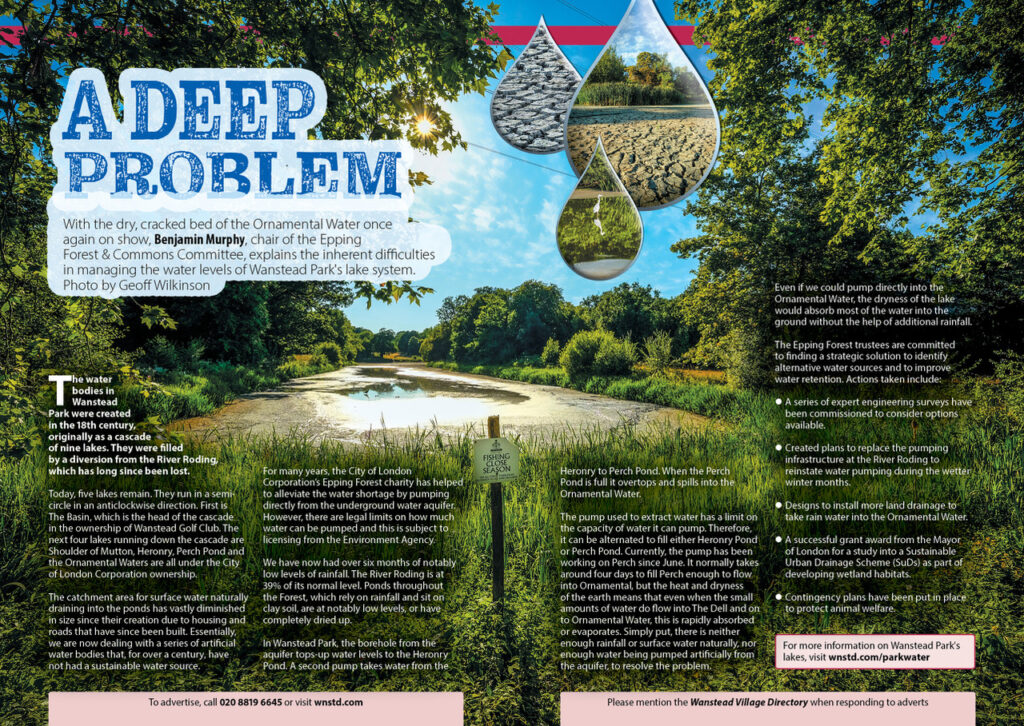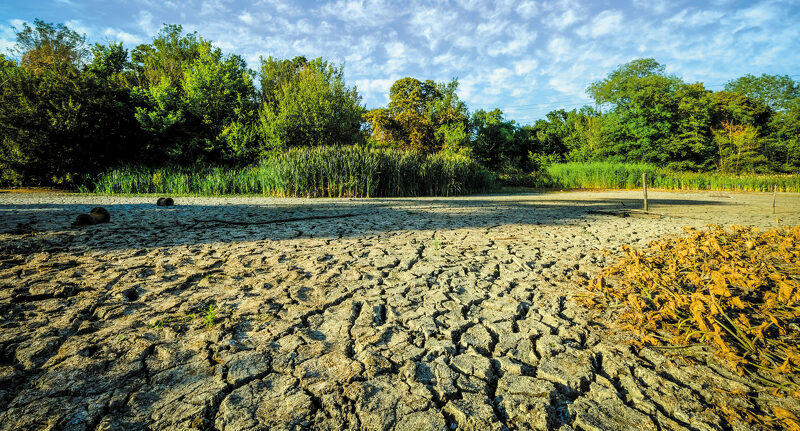A deep problem – Wanstead Village Directory
With the dry, cracked bed of the Ornamental Water once again on show, Benjamin Murphy, chair of the Epping Forest & Commons Committee, explains the inherent difficulties in managing the water levels of Wanstead Park’s lake system. Photo by Geoff Wilkinson
The water bodies in Wanstead Park were created in the 18th century, originally as a cascade of nine lakes. They were filled by a diversion from the River Roding,
which has long since been lost.
Today, five lakes remain. They run in a semi-circle in an anticlockwise direction. First is The Basin, which is the head of the cascade in the ownership of Wanstead Golf Club. The next four lakes running down the cascade are Shoulder of Mutton Pond, Heronry Pond, Perch Pond and the Ornamental Water, all under City of London Corporation ownership.
The catchment area for surface water naturally draining into the ponds has vastly diminished in size since their creation due to housing and roads that have since been built. Essentially, we are now dealing with a series of artificial water bodies that, for over a century, have not had a sustainable water source.
For many years, the City of London Corporation’s Epping Forest charity has helped to alleviate the water shortage by pumping directly from the underground water aquifer. However, there are legal limits on how much water can be pumped and this is subject to licensing from the Environment Agency.
We have now had over six months of notably low levels of rainfall. The River Roding is at 39% of its normal level. Ponds throughout the Forest, which rely on rainfall and sit on clay soil, are at notably low levels or have completely dried up.
In Wanstead Park, the borehole from the aquifer tops up water levels to the Heronry Pond. A second pump takes water from the Heronry to Perch Pond. When the Perch Pond is full it overtops and spills into the Ornamental Water.
The pump used to extract water has a limit on the capacity of water it can pump. Therefore, it can be alternated to fill either Heronry Pond or Perch Pond. The pump has been working on Perch since June. It normally takes around four days to fill Perch enough to flow into Ornamental, but the heat and dryness of the earth means that even when the small amounts of water do flow into The Dell and on to Ornamental Water, this is rapidly absorbed or evaporates. Simply put, there is neither enough rainfall nor surface water naturally, nor enough water being pumped artificially from the aquifer, to resolve the problem.
Even if we could pump directly into the Ornamental Water, the dryness of the lake would absorb most of the water into the ground without the help of additional rainfall.
The Epping Forest trustees are committed to finding a strategic solution to identify alternative water sources and to improve water retention. Actions taken include:
- A series of expert engineering surveys have been commissioned to consider options available.
- Created plans to replace the pumping infrastructure at the River Roding to reinstate water pumping during the wetter winter months.
- Designs to install more land drainage to take rainwater into the Ornamental Water.
- A successful grant award from the Mayor of London for a study into a Sustainable Urban Drainage Scheme (SuDs) as part of developing wetland habitats.
- Contingency plans have been put in place to protect animal welfare.

